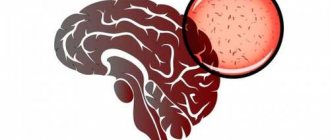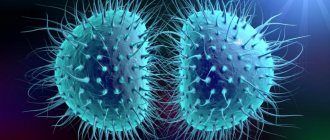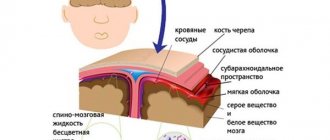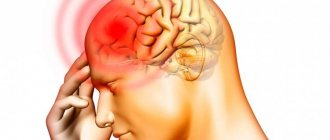Author's rating
Author of the article
Smirnova Olga Leonidovna
Neurologist, education: First Moscow State Medical University named after I.M. Sechenov. Work experience 20 years.
Articles written
94
Signs of meningitis in children can vary. It all depends on the type and stage of development of the disease. Meningitis is an acute and rapidly occurring inflammation of the membranes of the brain. Most often, the pathology affects children. This is due to the body’s reduced ability to resist viruses, fungi and bacteria. It is very important to identify the disease in time and begin treatment, since the consequences of meningitis can be very serious.
Causes leading to the appearance of the disease
Inflammation in the meninges can occur for various reasons. The vast majority are infectious. However, there are also non-infectious causes. So, what can cause meningitis in a child:
- meningococcal infection;
- enterovirus infection;
- herpetic infection;
- tick-borne encephalitis;
- E. coli (in newborns);
- meningitis caused by opportunistic infections (with HIV);
- post-traumatic inflammation;
- inflammation that has passed from nearby organs - ear, eye, sinuses of the skull bones, oral cavity;
- tumor meningitis.
As you can see, there are many reasons for the development of this disease in children. There are also very rare types of meningitis - parasitic, due to systemic diseases or genetic disorders. Each type of disease occurs with its own characteristics.
Features of the development of the disease in children
Different age groups experience the disease differently. Newborns and children of the first years of life cannot say what is bothering them.
Their only complaint will be continuous crying. In such children, general cerebral symptoms come to the fore in the clinical picture, masking the true disease. Therefore, in this age period there is a late diagnosis, and as a result, a higher incidence of complications.
Older children can already tell what worries them. The symptoms of meningitis in them already resemble those in adults.
The characteristic signs of damage to the meninges are more clearly expressed. In older children, it is easier to perform specific tests to detect neurological disorders. The incidence of complications and deaths is reduced. The disease is generally milder than in newborns.
Complications after meningitis in children
In the case of children, complications and consequences after meningitis (and especially meningococcal meningitis) can be more than catastrophic. Among the most negative:
- severe and regular headaches;
- pronounced delays in physical and emotional development;
- severe mental development disorders;
- epilepsy;
- loss of vision and hearing;
- cramps (spontaneous muscle contractions);
- renal failure;
- cerebral edema;
However, all of the listed sad consequences of meningitis relate in the vast majority of cases to advanced bacterial forms of the disease, to which neither parents nor doctors responded in time.
The occurrence of complications after meningitis in children is directly related to two factors - which microbe caused the disease and how quickly adequate treatment was started. That is, in this case, it is your parental observation, quick reaction and persistent desire to “show” the child to specialists at the first suspicion of meningitis, as a rule, that are the key to a successful recovery without consequences.
General symptoms
All meningitis in children occurs with approximately the same clinical picture; they are characterized by specific symptoms and signs by which a specialist can make a diagnosis.
The main complaint made by children is headache. It can vary in severity, but in most cases the pain is intense and is usually accompanied by nausea and repeated vomiting. It is characteristic that after vomiting the child does not feel better, as happens with a regular headache or migraine.
The next sign, determined objectively, is the presence of specific symptoms - meningeal. They appear due to irritation of the meninges by microorganisms or toxins. What are the meningeal symptoms:
- In young children, the symptom of Lesage , or suspension, is determined - the child is taken by the armpits and lifted. Due to irritation of the meninges, a reflex flexion of the legs occurs.
- In children with not yet closed fontanelles, their condition is assessed - a sign of pathology of the meninges is bulging of the fontanelles .
- Rigidity of the muscles of the neck and back of the head - the child is asked to relax his neck and his head is tilted to the chest. If meningitis is present, the child will not be able to reach the sternum with his chin and will complain of pain in the head.
- There are also three varieties of Brudzinski's sign - upper, middle and lower. The essence of the symptom is the reflex bending of the legs when the position of the head changes.
These are symptoms characteristic of inflammation of the meninges, the presence of which is an indication for a lumbar puncture and confirmation of the diagnosis.
Symptoms depending on the type
There are different types of meningitis in children, each of which manifests itself differently. The symptoms of the pathological process are also affected by the age of the baby.
Serous meningitis is common in children. In this condition, serous fluid begins to accumulate in the brain. The disease develops due to the entry of an enterovirus into the body. If help is not provided in time, the child may become disabled and even die. The distinctive symptoms of this condition are:
- elevated body temperature, which cannot be normalized with medications;
- nausea and severe vomiting;
- general weakness.
If the virus comes into contact with food or drinking water, the stomach may hurt, bloating, and diarrhea may appear. Airborne infection leads to a runny nose and a sore throat.
Serous meningitis in children can be determined by the following signs:
- severe pain in the head, due to which the child screams non-stop;
- high fever;
- lethargy;
- fear of light and noise;
- chills;
- the baby's fontanelle is pulsating;
- hearing is impaired, hallucinations occur;
- skin becomes more sensitive;
- muscle tension and cramps occur.
Viral meningitis in children is similar to a viral infection. Manifestations of viral meningitis in children can be as follows:
- severe nausea and vomiting;
- inflammation of the nasal mucosa;
- loss of appetite;
- spotty rash;
- muscle tension according to Kerning, Brudzinsky.
Every mother should know the signs of meningitis in infants, since in these cases the development of the disease is especially dangerous. The child may cry for a long time and for no apparent reason, and becomes capricious and agitated. Experts can assume the development of inflammation of the meninges based on the following signs:
- Loose stools.
- Excessive regurgitation and vomiting.
- Abnormal response to touch.
- Bulging of the fontanel.
- Decreased muscle tone and cramps.
- Lesage's sign.
- The appearance of a rash on the mucous membranes.
At the age of three, it is already easier to diagnose the disease, since the child can independently describe his feelings. In such cases, the child will hide under the blanket and become irritated by the slightest noise. Body temperature may rise, and after 2-3 days it may subside, then it will rise again. Meningeal signs at this age include:
- muscle aches;
- weakness and general malaise;
- hearing impairment and tinnitus;
- soreness from touching;
- delirium in sleep;
- chills and convulsions;
- muscle tension.
The first symptoms of meningitis in children over five years of age will be slightly different. Inflammation of the membranes of the brain is primarily manifested by high fever and severe vomiting.
Symptoms of meningitis in teenagers will be:
- The mucous membrane of the throat turns red, and it becomes difficult to swallow.
- Confusion occurs.
- Limbs go numb.
- My stomach starts to hurt sharply.
- The whites of the eyes turn yellow and cloudy.
- Muscle stiffness is felt.
- The face swells and turns red.
Meningococcal infection
Meningococcal meningitis is one of the clinical forms of meningococcal infection.
The disease has an acute onset, body temperature rises sharply to 40.0*C. The child is at first lethargic, then restless, and there is some clouding of consciousness. If he can complain, he will say that his whole head hurts a lot.
Pain intensifies when exposed to any external irritants - this is a characteristic symptom of meningococcal infection. By the third day of the disease, meningeal symptoms develop.
From the first day you may experience convulsions that persist for a long time. Vomiting often occurs, after which the child does not feel relief.
Externally, the child is pale, his face is swollen. Breathing and heart rate increase. When palpating the abdomen, pain may be noted; in some cases, the liver and spleen are enlarged.
Enterovirus infection
Inflammation of the meninges during enterovirus infection is caused by viruses of the Coxsackie and ECHO groups. Like any viral meningitis, this one will be serous - without purulent inflammation.
Characterized by a sharp onset with a rise in body temperature to 39.0*C. The child becomes restless and finds no place for himself. Small children scream constantly; slightly older children will complain of severe headaches. In severe cases, disorientation in time and space may occur.
The headache is accompanied by repeated vomiting, and the child may complain of pain in the abdomen and muscles. Externally, redness of the face and neck and mucous membranes can be noted. Meningeal symptoms appear early and intensify with increasing temperature.
Tick-borne encephalitis as a provocateur of meningitis
In almost all cases, the onset of the disease can be associated with a tick bite. Meningitis is not caused by the tick itself, but by a virus carried by an insect.
There is a sharp rise in body temperature to 39.0-40.0*C. The child is worried and sweats excessively. He will complain of a sharp headache accompanied by nausea. If vomiting occurs, it does not bring relief to the child.
Externally, redness of the upper half of the body, face, and mucous membranes is observed. Meningeal symptoms can occur either at the onset of the disease or after a few days.
Characteristic signs of increased intracranial pressure are weakened reflexes, different pupil sizes, floating movements of the eyeballs.
Distinctive signs of meningitis in a teenager
A distinctive sign of meningitis is meningeal syndrome. You can identify it using the following methods:
- Kernig's sign. With this symptom, the patient is unable to straighten the leg, which is bent at the knee and hip joints.
- Upper and lower Brudzinski symptoms. With the upper symptom, when the head is pulled to the chest, the legs automatically bend; with the lower symptom, bending one leg, the patient also bends the other.
Meningeal symptoms can occur with meningism, which is irritation of the meninges without inflammation. These symptoms are specific, but there are always exceptions.
Meningitis rash in teenagers
The appearance of a rash during meningitis is considered a poor prognostic sign. The rash indicates that the causative agent of meningitis has entered the general bloodstream, and the process has become a systemic phenomenon. That is, we are talking about sepsis or blood poisoning.
If the necessary treatment measures are not taken, 9 out of 10 patients die.
The rash itself is a rash that first appears on the stomach, torso, and then moves to the limbs and face. This rash is unlike other rashes in appearance and structure.
When pressed, it does not change its color and does not cease to be visible. Elements of this rash occur as a result of hemorrhages in the upper layers of the skin capillaries, that is, it is hemorrhagic in origin. This explains its characteristic purple color. The causative agents of meningitis affect the endothelium of blood vessels, which leads to necrosis of the latter.
A rash is a sign of extremely severe meningitis. Subsequently, the elements of the rash merge with each other, forming large areas of hemorrhage.
Herpetic inflammation
Herpetic meningitis in children is very rare. It develops when a child is infected with herpes virus type 2. It may
The photo shows a rash with herpetic meningitis
happen when an infected mother passes through the birth canal or through close contact with a sick person.
The disease is characterized by severe headache and nausea. The child may block out the light. Meningeal symptoms are not pronounced.
Externally, with herpetic meningitis, a herpetic rash is observed on the face of children, and in severe cases - on the skin of the torso.
Prevention
The main method of preventing meningitis in children at present is vaccination. The creation of artificial immunity begins in the first year of a child’s life. Currently, vaccination is used against many dangerous pathogens - bacteria and viruses.
Vaccination of children against meningitis pathogens - table
| Type of vaccine | Vaccination age | Contraindications | Examples of vaccine preparations |
| Comprehensive vaccine against measles, rubella, mumps |
|
|
|
| Vaccine against tuberculosis |
|
|
|
| Vaccine against meningococcal disease |
|
|
|
| Vaccine against Haemophilus influenzae |
|
|
|
| Vaccine against pneumococcal infection |
|
|
|
Hematogenous and lymphogenous inflammation
Children with reduced immunity and the presence of chronic foci of infection may develop inflammation caused by infection brought through the blood and lymph.
Such foci include carious teeth and chronic tonsillitis. In newborns, inflammation can spread to the meninges from the auditory tube.
Meningitis in these cases will be preceded by any of the above diseases. A high temperature is not typical, nor is an acute onset. The inflammatory process develops gradually.
Meningeal symptoms are mild. However, such inflammation is dangerous because it quickly spreads to the brain substance and meningoencephalitis develops.
Meningitis and natural protection of the child’s brain from infections
The brain in every organism, including adults and children, is structured in a very original way. It is based on special cells - neurons. They have many outgrowths for receiving and transmitting electrical signals from all internal organs, muscles, ligaments and skin. The nerve cells themselves make up the gray matter, the processes make up the white matter. The peculiar role of electrical insulation and at the same time a nurse and protector is performed by smaller cells - neuroglia.
Neuron is the basic structural unit of the brain
Neuroglia are part of the blood-brain barrier. Like other organs, the brain receives nutrition from the general bloodstream. However, its vessels are surrounded throughout their entire length by neuroglia as a kind of palisade. These service cells do not allow anything inside that could pose a danger to neurons. It's not just bacteria and viruses. Even your own immune cells cannot penetrate this protective barrier.
The blood-brain barrier is the main defense of the brain against infections and other harmful factors.
Another level of protection of the brain from uninvited guests are the membranes - soft, arachnoid and hard. They are made of strong connective tissue. The membranes play the role of a shock absorber, located between the substance of the brain and the bones of the skull. In addition, large venous vessels pass within these structures. The three meninges together form another protective barrier against infection, toxins and other harmful substances.
The membranes of the brain perform a protective function
Meningitis is the medical term for inflammation of the lining of the brain. Children, due to their imperfect immunity, are susceptible to this serious disease to a much greater extent than adults. Meningitis is especially dangerous for newborns and infants.
Meningitis - video
Diagnosis of the disease
The diagnosis is made based on the characteristic clinical picture and examination results.
Typical symptoms that suggest meningitis in children are an indication for a diagnostic lumbar puncture. In the presence of inflammation of the meninges, cerebrospinal fluid flows out of the needle under tension, in frequent drops or even a stream.
You can even assess changes in cerebrospinal fluid by eye. In serous meningitis caused by viruses, the cerebrospinal fluid will be clear. With bacterial inflammation, pus appears in the cerebrospinal fluid, and then the liquid will be cloudy.
Next, the cerebrospinal fluid is sent to the laboratory for biochemical testing. There, the degree of increase in glucose, lymphocytes, neutrophils and protein is assessed. CSF can be tested using polymerase chain reaction to detect DNA or RNA of the pathogen. Cerebrospinal fluid is also inoculated onto nutrient media.
General tests - blood and urine - assess the severity of the inflammatory process in the body. An enzyme immunoassay in blood detects specific antibodies to the causative agent of the disease. If necessary, X-rays of the skull and computed tomography of the head are prescribed.
Pathogenesis of the disease
The brain and spinal cord are covered by 2 types of membranes: hard and soft . Depending on which membranes of the brain were inflamed, the following types of meningitis differ:
Pachymeningitis. This type of pathology develops when the dura mater is damaged. Very rare.
- Meningitis. The disease is diagnosed by inflammation of the soft membranes. This is the most common form of meningitis.
- Panmeningitis. It is detected when the infection captures the hard and soft membranes at the same time.
Meningitis is one of the most dangerous diseases.
Before the advent of antibiotics, this disease led to the death of 95% of patients. A significant decrease in death statistics occurred only after the invention of penicillin. Today, doctors successfully fight meningitis using powerful synthetic drugs. Moreover, vaccines have been developed against the most active pathogens of the disease, which help prevent the development of pathology.
Outbreaks of meningitis are seasonal. Most patients are identified between November and April. This frequency is due to vitamin deficiency, large crowding of people in the premises, and insufficient ventilation of buildings.
According to scientists, this disease has an annual cycle. Once every 10 years there is a significant increase in incidence.
Primary meningitis is an infectious disease . It is caused by viruses and bacteria and spreads in the following ways:
- Airborne. The causative agent of the disease enters the external environment when coughing and sneezing.
- Contact and household. The infection can be transmitted through direct contact with its carrier or through the use of common household items.
- Oral-fecal. We are talking about non-compliance with hygiene rules: eating food that has not been processed; eating with unwashed hands, etc.
- Hematogenous. The infection spreads throughout the body through the bloodstream.
- Lymphogenic. The disease spreads through the lymph flow.
- Placental. The infection is transmitted to the baby through the placenta or during movement in the birth canal.
- Oral. Infection occurs through ingestion of untreated water or swimming in dirty bodies of water.
The disease develops gradually. The infection first enters the child's body through the lungs or gastrointestinal tract. Then it takes hold in the body and begins to multiply. At a certain point, infectious agents are carried through the bloodstream throughout the body and reach the meninges of the spinal cord and brain. Direct inflammation of these membranes occurs only if the infection manages to overcome the blood-brain barrier. After this, the patient experiences the first symptoms of meningitis.
Providing medical care
Hospitalization is required. Treatment depends on the cause of the meningitis. First of all, the child is prescribed a therapeutic and protective regime, in which complete rest is observed and external stimuli are excluded.
Treatment is selected depending on the form of meningitis:
- meningococcal is treated with Penicillin intravenously, in dosages appropriate to the child’s age;
- for enteroviral lesions ; in some cases, intravenous interferons are used, but there is no scientific evidence of their effectiveness;
- herpetic lesions require the administration of Acyclovir intravenously in dosages appropriate for age;
- non-infectious inflammations are treated symptomatically and pathogenetically.
Symptomatic therapy:
- to prevent cerebral edema, Diacarb is prescribed in combination with Furosemide;
- Vinpocetine and Pentoxifylline help improve cerebral circulation
- at elevated temperatures , antipyretic drugs are prescribed; for severe vomiting , metoclopramide is prescribed intramuscularly;
- in the presence of chronic foci of infection, their sanitation is carried out.
If there is no threat of cerebral edema, infusion therapy is prescribed for faster detoxification. The timing of treatment will also depend on the cause of the meningitis.
Why is self-medication dangerous?
Meningitis is a very dangerous disease, the occurrence of which in a teenager often poses a threat to life.
It is important to understand that self-medication is not acceptable here, since sometimes the countdown of time can already go to the clock. Urgent intervention by professionals in white coats is required. Therapy should be carried out exclusively in a medical institution , where treatment is prescribed by a doctor according to a special regimen, including antibiotics, vitamins and diuretics.
It is important to understand that the final result largely depends on the stage at which full treatment began. When the disease starts, in the best case, serious consequences can occur; in the worst case, the teenager dies.
So, the main complications of meningitis in a teenager include :
- the occurrence of blindness;
- strabismus;
- paralysis of various parts of the body;
- development of bedsores;
- developmental delay.
Read more about treating meningitis at home in this article.
Consequences and prevention
The worst outcome, of course, is death. Its likelihood increases with late diagnosis of the disease. If meningitis is not diagnosed in the first three days and treatment is not started, death is observed in 90% of cases.
However, even with timely treatment and recovery of the child, long-term consequences, mostly neurological, may remain. The child may be bothered by frequent headaches, and there may be a slight decrease in intelligence.
Preventive measures include receiving all preventive vaccinations against meningitis required for all children by age.
Sanitation of chronic foci of infection is mandatory. During the cold season, when meningococcal infection becomes more active, it is necessary to protect the child from contact with coughing and sneezing people.











